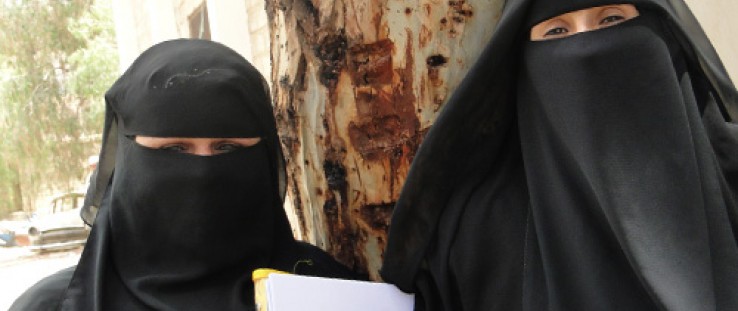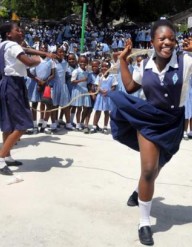 Basic Health Services Project
Basic Health Services Project
 Basic Health Services Project
Basic Health Services Project
"I want to be an English teacher!"
"A journalist!"
"I will be a doctor!"
A dozen Yemeni girls sit on the floor of a diwan in Al Sawd village, giggling and smiling bashfully as they describe what they hope to be doing in 10 years. They are between 8 and 15 years old, and are fortunate to attend one of the few local schools for girls.
In this remote corner of northwest Yemen, most of their female peers have already ended their schooling. While this group can still afford to dream, the grim reality is that most girls their age will soon be married, without a chance to complete their education or have a career.
Yemen is one of 20 "hot spot" countries for child marriage, a conservative Muslim nation where a seventh of all girls are married by age 14 and nearly half by age 17. In rural districts, girls as young as 9 are often betrothed. Most "hot spot" countries are clustered in central Africa, with other pockets in Southeast Asia and Central America.
Various factors have institutionalized child marriage. For some, it is a tribal custom. For others, exchanging daughters without dowries in "trade marriages" makes economic sense.
Regardless of its causes, child marriage represents a human rights infringement and a public health problem. It deprives young girls of a childhood, enhances their risk of domestic abuse, and entraps them in a cycle of poverty.
The health consequences are also dire. According to the World Health Organization, the maternal mortality rate is five times higher for adolescent girls under age 15 than those over 20, and the health outcomes for their infants are similarly poor.
USAID has confronted this issue with its Safe Age of Marriage (SAM) program, designed to change social norms around early marriage, girls' education, and children's rights. In partnership with the Yemeni Women's Union, the pilot program was implemented in two districts in the Amran governorate starting in 2009.
Leaders of the Community
A land of treacherous roads and dust-colored houses built into the mountain steppes, the Al Sawd and Al Soodah districts in Amran represent some of the most isolated regions in Yemen. Most of the population is illiterate and 71 percent of mothers are married before age 18. In these rural communities, USAID support trained 40 community leaders on the social and health benefits of delaying marriage. It also taught them how to share this knowledge with others.
"The community educators themselves decided the best way to talk about early marriage," explains Leah Freij, a senior gender adviser with the USAID-funded Extending Service Delivery Project. "They went to schools. They distributed newsletters. They talked to women in their homes."
They also garnered support from the Ministries of Education and Public Health and Population, which spoke at monthly fairs on the safe age of marriage. As the program gained traction, even the governor of Amran got involved—he personally awarded 12 "model families" in a ceremony for not only delaying their daughters' marriages, but also for educating them through 12th grade.
Piloting Results
The initial results of this pilot are promising. In one year, community educators reached 29,000 people, leading to an 18 percent jump in awareness in the benefits of delaying marriage. The program was instrumental in preventing 53 girl-child marriages.
It shifted the peak age of girls' marriage from 14 to 18 years old in the project area. Several villagers asked community educators to help them annul their daughters' marriages, and in one instance a community educator ended an engagement by paying back the family's dowry himself. In addition, the Ministry of Endowment and Guidance in Amran directed all religious leaders in the governorate to speak about the consequences of child marriage in their Friday sermons. Not long afterwards, the entire Al Soodah community took an oath to forbid child marriage for girls under 18.
"This is a big accomplishment," says Freij. "This is changing social norms."
According to Dalia Al Eryani, the lead program coordinator, the program's greatest benefit is getting information to an area usually deprived of it. "One woman thought her daughter was cursed because she kept having miscarriages," she recounts. "She went from healer to healer. When the daughter turned 18, she finally gave birth to a healthy boy. When we came and talked about early marriage, the woman said, 'Oh, this explains what happened to my daughter.' It's a real eye-opener."
USAID's support is part of a broader effort to ensure that community leaders—including religious leaders and midwives—are informed and help community members make sound decisions for themselves and their children, notes Sean Jones, USAID/ Yemen's technical program director.
Community educators and traditional leaders continue to be both sources of information and role models. Freij points to the community educator who led the schoolgirl discussion. She was married and still completed college with her husband's support.
"The girls used to think you had to choose between an education and marriage," says Freij. "Now they see they can have both."
For more information on the Extending Service Delivery and Basic Health Services projects, visit: www.esdproj.org.
For more on USAID's efforts to combat child marriage, see "Combating Early Marriage from the Ground Up."









Comment
Make a general inquiry or suggest an improvement.